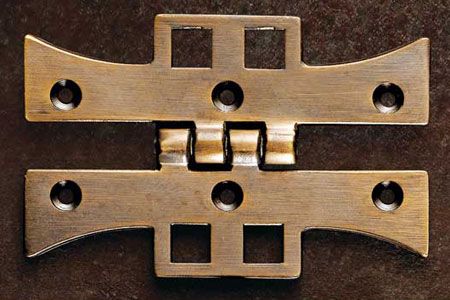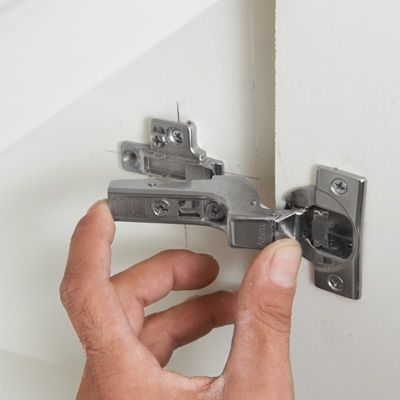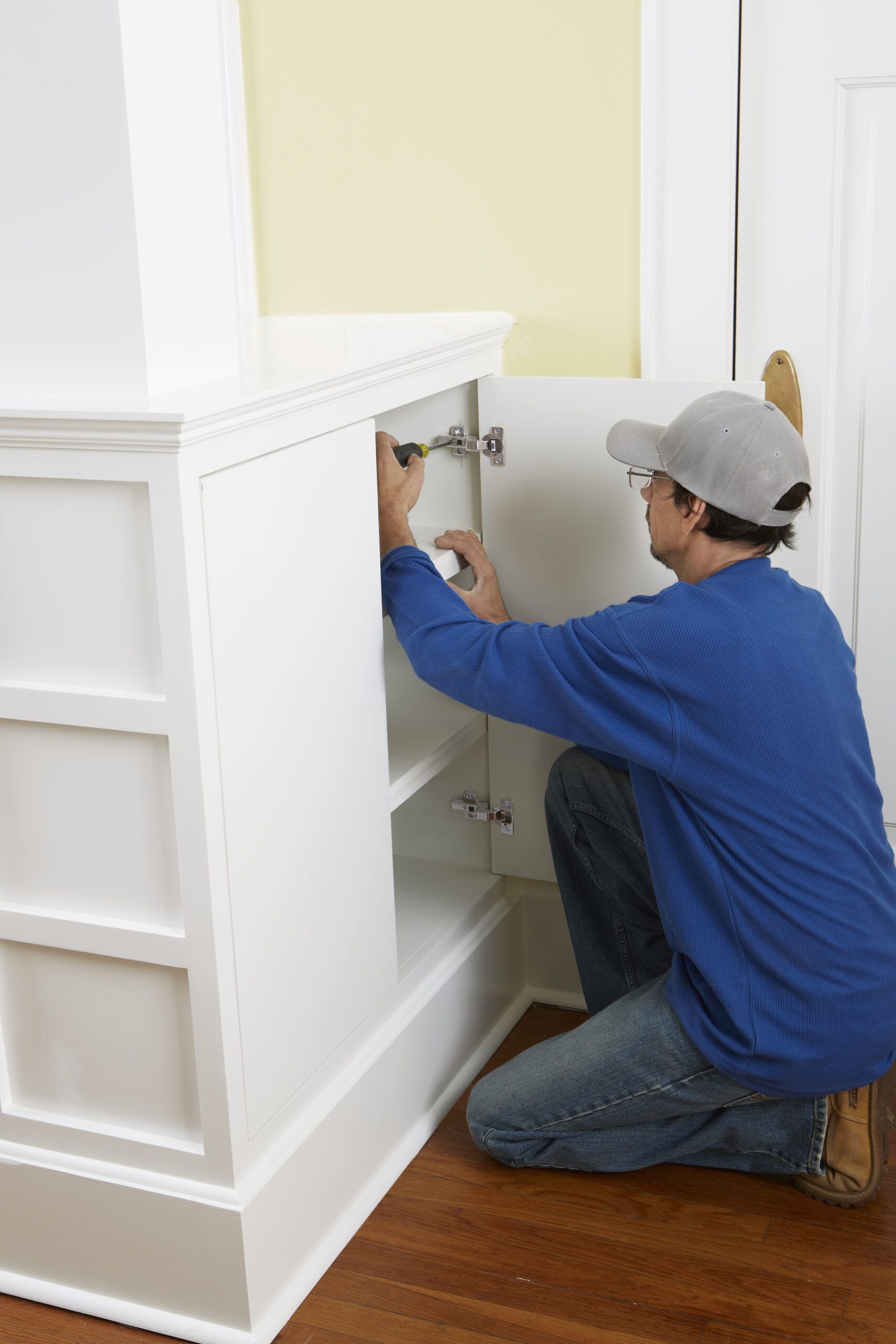Cabinets are an essential part of any kitchen or bathroom, but over time, you may notice that your cabinet doors become loose, sag, or no longer close properly. This guide will walk you through the process of determining the cause of loose cabinet door hinges and fixing them. Whether you’re dealing with loosened screws, stripped hinge holes, or sagging doors, we’ll cover the tools, techniques, and preventative measures you need to keep your cabinets functioning smoothly.
Common Causes of Loose Cabinet Doors
Typically, when cabinet doors or their hinges have come loose, it’s due to one of the following issues.
Loosened Screws Over Time
The most common and straightforward cause of loose cabinet doors is screws that have gradually worked their way out over time. This is especially true for cabinets that see frequent use, such as those containing everyday items like glasses or snacks. As doors are opened and closed repeatedly, the vibrations can cause screws to loosen incrementally.
Stripped Hinge Holes
Another frequent issue is stripped hinge holes. This occurs when the wood around the screw has worn away, making the hole too large for the screw to grip effectively. Stripped holes can result from overtightening screws, using the wrong size screws, or simply from years of use and adjustments.
Sagging Due to Weight
Sometimes, cabinet doors may become loose or misaligned because they’re too heavy for their current hardware. This is often seen with larger doors or those made from dense materials. Over time, the weight of the door can strain the hinges, causing them to loosen or the door to sag.
Tools and Materials Needed for Cabinet Hinge Repair
You’ll need a screwdriver for any of the following repairs, so check whether your cabinet hinges require a flathead or a Phillips head. Depending on the type of repair, you may also need the following tools and materials.
- Wood glue
- Toothpicks
- Wood screws (various sizes)
- Replacement hinges
- Wood filler
- Dowel
- Drill (for more extensive repairs)
Tightening Loose Cabinet Hinge Screws
Tightening loose screws on cabinet hinges is often the first and simplest solution to try. Begin by carefully examining the hinges on your cabinet doors. Look for any visible signs of wear, damage, or misalignment.
- Identify loose or protruding screws.
- Open the cabinet door fully to access the hinges.
- Using the appropriate screwdriver, carefully tighten each screw on both the cabinet frame and door side of the hinge.
- Be cautious not to overtighten, as this can strip the screw holes or damage the wood.
Once you’re finished, close the door to check its alignment and tension. The door should close smoothly and sit flush with the cabinet frame. If misalignment persists, you may need to make further adjustments to the hinge position.
Fixing Stripped Hinge Holes
If tightening the screws doesn’t solve the problem, you may be dealing with stripped hinge holes. You’ll need to fill the hole with something sturdy enough to support the screw.
The Toothpick and Wood Glue Method
This tried-and-true method creates a new wood surface for the screw to grip, effectively repairing the stripped hole.
- Remove the hinge from the cabinet, keeping the door safely aside.
- Dip the ends of several wooden toothpicks into wood glue.
- Insert the glue-covered toothpicks into the stripped hole, using as many as it takes to pack the hole completely.
- Cut or break off the protruding ends of the toothpicks so they’re flush with the cabinet surface.
- Allow the glue to dry completely before reattaching the hinge.
Alternative Repair Options
If the toothpick method doesn’t provide enough support, consider these alternatives:
- Use a larger screw: Sometimes, simply using a slightly larger screw can solve the problem.
- Wood filler: For more extensive damage, fill the hole with wood filler, let it dry, then drill a pilot hole before reinserting the screw.
- Dowel plug: For severely damaged holes, drill out the old hole, glue in a wooden dowel, and then drill a new pilot hole once dry.

Addressing Sagging Cabinet Doors

Sagging doors often require more than just tightening screws. If your cabinet doors are drooping or misaligned due to weight, you may need to upgrade your hardware.
Replacing with Stronger Hinges
If your current hinges can’t support the door’s weight:
- Measure your existing hinges and note their type (e.g., concealed, surface-mounted).
- Purchase new hinges rated for heavier doors.
- Remove the old hinges and install the new ones, ensuring they’re properly aligned.
Adding Additional Hinges for Support
For particularly heavy doors, adding an extra set of hinges can help distribute the weight:
- Determine the best placement for the additional hinges, typically centered between existing ones.
- Mark and drill pilot holes for the new hinges.
- Install the new hinges, ensuring they’re level with the existing ones.
- Adjust all hinges as needed to ensure proper door alignment.
Troubleshooting Persistent Hinge Issues
Sometimes, despite your best efforts, cabinet hinge problems may persist. In these cases, consider calling a contractor or professional cabinet installer to identify the larger problem:
- Doors that won’t stay aligned despite repeated adjustments
- Very large or heavy cabinet doors
- Extensive damage to the cabinet frame or door
- Antique or specialty cabinets that require expert handling
A skilled carpenter or cabinet maker can often solve complex issues and may spot problems you’ve overlooked.
Preventative Maintenance for Cabinet Hinges
Since dirt and grime can keep hinges from performing properly, you should wipe down hinges with a damp cloth every few months. For cabinets that encounter more dirt, like those in a garage or mudroom, use a mild soap solution. Apart from cleaning, here are some other ways to keep hinges working well.
Lubrication
Periodically lubricating your hinges can prevent squeaking and ensure smoother operation.
- Choose an appropriate lubricant, such as WD-40 or a silicone-based spray.
- Apply the lubricant sparingly to the hinge’s moving parts.
- Open and close the door several times to distribute the lubricant evenly.
Monitoring for Early Signs of Damage
Being proactive can save you from more extensive repairs down the line. Inspect your hinges once or twice a year. for early signs of damage:
- Look for any signs of metal fatigue or rust.
- Check that all screws remain tight and that none have worked loose. Gently tighten as necessary.
- Pay attention to any new noises, such as creaking or clicking.
Soft-Close and Concealed Cabinet Hinges
Standard hinges are the most budget-friendly option, but if you want to upgrade the look and function of your cabinets, consider switching to soft-close or concealed hinges.
Soft-Close Mechanisms
Soft-close hinges are a popular upgrade for modern kitchens and bathrooms. These hinges prevent the door from slamming shut and help prolong the life of your cabinets by reducing stress on the doors and frame. Installation is straightforward and can often be done without needing to drill new holes. Learn more about this upgrade in our guide on how to upgrade to soft-close cabinets.
Concealed Hinges
Concealed hinges, also called invisible hinges, offer a sleek, modern look by hiding the hinge mechanism within the cabinet. They allow for smoother operation and can be adjusted for precise door alignment. Concealed hinges are available in a variety of styles to suit different cabinet designs. Installing concealed hinges is a bit more labor-intensive and may require drilling into cabinet doors, but it’s still well within the abilities of the average homeowner.
Our Conclusion
While cabinet doors don’t tend to require extensive maintenance, cleaning, lubricating, and keeping an eye on their hinges is usually a good idea. Fixing loose cabinet door hinges is a manageable DIY task that can significantly improve the functionality and appearance of your kitchen or bathroom. However, if you encounter persistent issues or feel uncomfortable with any repair steps, don’t hesitate to seek professional help.

